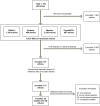Patient-Driven Second Opinions in Oncology: A Systematic Review
- PMID: 28606972
- PMCID: PMC5634767
- DOI: 10.1634/theoncologist.2016-0429
Patient-Driven Second Opinions in Oncology: A Systematic Review
Abstract
Background: Although patient-driven second opinions are increasingly sought in oncology, the desirability of this trend remains unknown. Therefore, this systematic review assesses evidence on the motivation for and frequency of requests for second opinions and examines how they evolve and their consequences for oncological practice.
Materials and methods: Relevant databases were sought using the terms "cancer," "second opinion," and "self-initiated." Included were peer-reviewed articles that reported on patient-initiated second opinions within oncology. Selection, data extraction, and quality assessment were performed and discussed by two researchers.
Results: Of the 25 included studies, the methodological designs were qualitative (n = 4), mixed (n = 1), or quantitative (n = 20). Study quality was rated high for 10 studies, moderate for eight, and low for seven studies. Reported rates of second opinion seeking ranged from 1%-88%. Higher education was most consistently related to seeking a second opinion. Patients' primary motivations were a perceived need for certainty or confirmation, a lack of trust, dissatisfaction with communication, and/or a need for more (personalized) information. Reported rates of diagnostic or therapeutic discrepancies between the first and second opinions ranged from 2%-51%.
Discussion: Additional studies are required to further examine the medical, practical, and psychological consequences of second opinions for patients and oncologists. Future studies could compare the potential advantages and disadvantages of second opinion seeking, and might offer guidance to patients and physicians to better facilitate the second opinion process. Some practical recommendations are provided for oncologists to optimally discuss and conduct second opinions with their patients. The Oncologist 2017;22:1197-1211 IMPLICATIONS FOR PRACTICE: Although cancer patients increasingly seek a second opinion, the benefits of this process remain unclear. Results of this systematic review suggest that the available studies on this topic are highly variable in both methodology and quality. Moreover, reported rates for a second opinion (1%-88%) as well as for disagreement between the first and second opinion (2%-51%) range widely. The primary motivations of patients are a need for certainty, lack of trust, dissatisfaction with communication, and/or a need for more (personalized) information. Additional research should evaluate how unnecessary second opinions might be avoided. Practical suggestions are provided for oncologists to optimize second opinions.
Keywords: Cancer; Physician‐patient relations; Quality of care; Referral and consultation; Review; Second opinion.
© AlphaMed Press 2017.
Conflict of interest statement
Disclosures of potential conflicts of interest may be found at the end of this article.
Figures


References
-
- Moumjid N, Gafni A, Bremond A et al. Seeking a second opinion: Do patients need a second opinion when practice guidelines exist? Health Policy 2007;80:43–50. - PubMed
-
- Heeft een patiënt recht op verwijzing voor een second opinion?: Available at https://www.knmg.nl/advies-richtlijnen/artseninfolijn/praktijkdilemmas-1.... Accessed May 25, 2017.
-
- Zorginstituut Nederland. Second opinion in de zorgverzekeringswet, 2015. Available at https://www.zorginstituutnederland.nl/publicaties/standpunten/2015/01/06.... Accessed May 25, 2017.
-
- Tattersall MH, Dear RF, Jansen J et al. Second opinions in oncology: The experiences of patients attending the Sydney Cancer Centre. Med J Aust 2009;191:209–212. - PubMed
-
- Rosenberg SN, Gorman SA, Snitzer S et al. Patients' reactions and physician‐patient communication in a mandatory surgical second‐opinion program. Med Care 1989;27:466–477. - PubMed
Publication types
MeSH terms
LinkOut - more resources
Full Text Sources
Other Literature Sources
Medical

